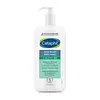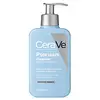What's inside
What's inside
 Key Ingredients
Key Ingredients

 Benefits
Benefits

 Concerns
Concerns

 Ingredients Side-by-side
Ingredients Side-by-side

Salicylic Acid 2%
MaskingBenzyl Alcohol
PerfumingButyrospermum Parkii Butter
Skin ConditioningCocamidopropyl Betaine
CleansingGlycerin
HumectantGlycine Soja Oil
EmollientGuar Hydroxypropyltrimonium Chloride
Skin ConditioningHydrogenated Soybean Oil
EmollientHydroxypropyl Starch Phosphate
Lactic Acid
BufferingLauric Acid
CleansingPalmitic Acid
EmollientPhenoxyethanol
PreservativeSodium Benzoate
MaskingSodium Chloride
MaskingSodium Hydroxide
BufferingSodium Lauroyl Glycinate
CleansingSodium Lauroyl Isethionate
CleansingStearic Acid
CleansingTetrasodium EDTA
Water
Skin ConditioningSalicylic Acid 2%, Benzyl Alcohol, Butyrospermum Parkii Butter, Cocamidopropyl Betaine, Glycerin, Glycine Soja Oil, Guar Hydroxypropyltrimonium Chloride, Hydrogenated Soybean Oil, Hydroxypropyl Starch Phosphate, Lactic Acid, Lauric Acid, Palmitic Acid, Phenoxyethanol, Sodium Benzoate, Sodium Chloride, Sodium Hydroxide, Sodium Lauroyl Glycinate, Sodium Lauroyl Isethionate, Stearic Acid, Tetrasodium EDTA, Water
Salicylic Acid 2%
MaskingWater
Skin ConditioningGlycerin
HumectantCapryl/Capramidopropyl Betaine
CleansingUrea
BufferingSodium C14-16 Olefin Sulfonate
CleansingShea Butteramidopropyl Betaine
CleansingPEG-150 Pentaerythrityl Tetrastearate
EmulsifyingLaureth-9
EmulsifyingSodium Lactate
BufferingNiacinamide
SmoothingEthoxydiglycol
HumectantSodium Chloride
MaskingGluconolactone
Skin ConditioningC12-13 Alkyl Lactate
EmollientCeramide NP
Skin ConditioningCeramide AP
Skin ConditioningCeramide EOP
Skin ConditioningCarbomer
Emulsion StabilisingSaccharide Isomerate
HumectantGlycolic Acid
BufferingCalcium Gluconate
HumectantSodium Benzoate
MaskingSodium Citrate
BufferingSodium Lauroyl Lactylate
EmulsifyingCholesterol
EmollientPhenoxyethanol
PreservativeDisodium EDTA
Tetrasodium EDTA
Citric Acid
BufferingHydrolyzed Hyaluronic Acid
HumectantLactic Acid
BufferingPhytosphingosine
Skin ConditioningXanthan Gum
EmulsifyingHexylene Glycol
EmulsifyingEthylhexylglycerin
Skin ConditioningBenzoic Acid
MaskingSalicylic Acid 2%, Water, Glycerin, Capryl/Capramidopropyl Betaine, Urea, Sodium C14-16 Olefin Sulfonate, Shea Butteramidopropyl Betaine, PEG-150 Pentaerythrityl Tetrastearate, Laureth-9, Sodium Lactate, Niacinamide, Ethoxydiglycol, Sodium Chloride, Gluconolactone, C12-13 Alkyl Lactate, Ceramide NP, Ceramide AP, Ceramide EOP, Carbomer, Saccharide Isomerate, Glycolic Acid, Calcium Gluconate, Sodium Benzoate, Sodium Citrate, Sodium Lauroyl Lactylate, Cholesterol, Phenoxyethanol, Disodium EDTA, Tetrasodium EDTA, Citric Acid, Hydrolyzed Hyaluronic Acid, Lactic Acid, Phytosphingosine, Xanthan Gum, Hexylene Glycol, Ethylhexylglycerin, Benzoic Acid
 Reviews
Reviews

Ingredients Explained
These ingredients are found in both products.
Ingredients higher up in an ingredient list are typically present in a larger amount.
Glycerin is already naturally found in your skin. It helps moisturize and protect your skin.
A study from 2016 found glycerin to be more effective as a humectant than AHAs and hyaluronic acid.
As a humectant, it helps the skin stay hydrated by pulling moisture to your skin. The low molecular weight of glycerin allows it to pull moisture into the deeper layers of your skin.
Hydrated skin improves your skin barrier; Your skin barrier helps protect against irritants and bacteria.
Glycerin has also been found to have antimicrobial and antiviral properties. Due to these properties, glycerin is often used in wound and burn treatments.
In cosmetics, glycerin is usually derived from plants such as soybean or palm. However, it can also be sourced from animals, such as tallow or animal fat.
This ingredient is organic, colorless, odorless, and non-toxic.
Glycerin is the name for this ingredient in American English. British English uses Glycerol/Glycerine.
Learn more about GlycerinLactic Acid is another well-loved alpha hydroxy acid (AHA). It is gentler than glycolic acid but still highly effective.
Its main role is to exfoliate the surface of the skin by loosening the “glue” that holds dead skin cells together. Shedding those old cells leads to smoother, softer, and more even-toned skin.
Because lactic acid molecules are larger than glycolic acid, they don’t penetrate as deeply. This means they’re less likely to sting or irritate, making it a great choice for beginners or those with sensitive skin.
Like glycolic acid, it can:
Lactic acid also acts as a humectant (like hyaluronic acid). It can draw water into the skin to improve hydration and also plays a role in the skin's natural moisturizing factor (NMF) in the form of sodium lactate.
Studies show it can boost ceramide production to strengthen the skin barrier and even help balance the skin’s microbiome.
To get results, choose products with a pH between 3-4.
Lower strengths (5-12%) focus on surface exfoliation; higher strengths (12% and up) can reach deeper in the dermis (deeper, supportive layer) to improve skin texture and firmness over time.
Though it was originally derived from milk, most modern lactic acid used in skincare is vegan. It is made through non-dairy fermentation to create a bio-identical and stable form suitable for all formulations.
When lactic acid shows up near the end of an ingredient list, it usually means the brand added just a tiny amount to adjust the product’s pH.
Legend has it that Cleopatra used to bathe in sour milk to help reduce wrinkles.
Lactic acid is truly a gentle multitasker: it exfoliates, hydrates, strengthens, and brightens. It's a great ingredient for giving your skin a smooth, glowing, and healthy look without the harshness of stronger acids.
Read more about some other popular AHA's here:
Learn more about Lactic AcidPhenoxyethanol is a preservative that has germicide, antimicrobial, and aromatic properties. Studies show that phenoxyethanol can prevent microbial growth. By itself, it has a scent that is similar to that of a rose.
It's often used in formulations along with Caprylyl Glycol to preserve the shelf life of products.
Salicylic Acid (also known as beta hydroxy acid or BHA) is a well-known ingredient for treating skin that struggles with acne and clogged pores. It exfoliates both the skin's surface and deep within the pores to help clear out buildup, control oil, and reduce inflammation.
Unlike AHAs (alpha hydroxy acids), salicylic acid is oil-soluble. This allows it to penetrate into pores which makes it especially effective for treating blackheads and preventing future breakouts.
Salicylic acid is also known for its soothing properties. It has a similar structure to aspirin and can calm inflamed or irritated skin, making it a good option for acne-prone skin that is also sensitive.
Concentrations of 0.5-2% are recognized by the U.S. FDA as an over-the-counter topical acne product.
It can cause irritation and/or dryness if one's skin already has a compromised moisture barrier, so it's best to focus on repairing that before introducing this ingredient into your routine.
While salicylic acid does not increase sun sensitivity, it’s still important to wear sunscreen daily to protect your skin.
If you are looking for the ingredient called BHA or Butylated Hydroxyanisole, click here.
Learn more about Salicylic AcidSodium Benzoate is a preservative. It's used in both cosmetic and food products to inhibit the growth of mold and bacteria. It is typically produced synthetically.
Both the US FDA and EU Health Committee have approved the use of sodium benzoate. In the US, levels of 0.1% (of the total product) are allowed.
Sodium benzoate works as a preservative by inhibiting the growth of bacteria inside of cells. It prevents the cell from fermenting a type of sugar using an enzyme called phosphofructokinase.
It is the salt of benzoic acid. Foods containing sodium benzoate include soda, salad dressings, condiments, fruit juices, wines, and snack foods.
Studies for using ascorbic acid and sodium benzoate in cosmetics are lacking, especially in skincare routines with multiple steps.
We always recommend speaking with a professional, such as a dermatologist, if you have any concerns.
Learn more about Sodium BenzoateChances are, you eat sodium chloride every day. Sodium Chloride is also known as table salt.
This ingredient has many purposes in skincare: thickener, emulsifier, and exfoliator.
You'll most likely find this ingredient in cleansers where it is used to create a gel-like texture. As an emulsifier, it also prevents ingredients from separating.
There is much debate on whether this ingredient is comedogenic. The short answer - comedogenic ratings don't tell the whole story. Learn more about comegodenic ratings here.
The concensus about this ingredient causing acne seems to be divided. Research is needed to understand if this ingredient does cause acne.
Scrubs may use salt as the primary exfoliating ingredient.
Learn more about Sodium ChlorideTetrasodium EDTA is the salt formed from neutralizing ethylenediamine tetraacetic acid with sodium hydroxide. It is a chelating agent and used to prevent metal ions from binding to other ingredients. This helps keep the product and ingredients stable.
Tetrasodium EDTA comes as a white solid and is soluble in water.
Water. It's the most common cosmetic ingredient of all. You'll usually see it at the top of ingredient lists, meaning that it makes up the largest part of the product.
So why is it so popular? Water most often acts as a solvent - this means that it helps dissolve other ingredients into the formulation.
You'll also recognize water as that liquid we all need to stay alive. If you see this, drink a glass of water. Stay hydrated!
Learn more about Water